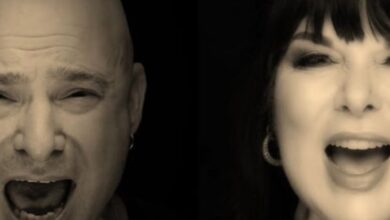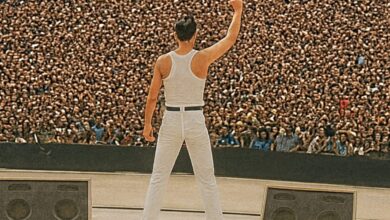Metal Singer Reimagines “A Whiter Shade of Pale” in a Powerful Modern Rendition
When Erik Grönwall resurfaced with his reimagined take on A Whiter Shade of Pale, it didn’t feel like just another cover tossed into the endless stream of internet renditions. It felt like a singer with deep classic-rock DNA reaching back to one of 1967’s most mysterious, most replayed, most argued-about songs and saying, “I grew up with this, I understand its melancholy, and I can make it speak to 2025.” He wasn’t trying to out-Procol Harum Procol Harum; he was trying to show what happens when a modern Scandinavian rock voice meets a baroque-pop ghost from the Summer of Love.
People who have followed Grönwall since his Swedish Idol win already knew he was fearless with big songs, but this choice still surprised them. A Whiter Shade of Pale is not like the usual showpieces singers pick—it’s not a fireworks anthem like “I Will Always Love You,” and it’s not a high-note stunt song. It’s a riddle in slow motion. The organ line, inspired by Bach, does half the emotional lifting, and the lyrics are so dreamlike that singers usually hide inside them. Grönwall did the opposite: he stepped right into the fog and sang it with the clarity of someone telling a real story.
What made the clip so charming was how unforced it felt. He didn’t come in with a wall of guitars blazing or a dramatic, over-arranged intro. Instead, he let the familiar melodic contour appear first—just enough to make listeners go, “oh, he’s doing that one”—and then slowly colored it with his own tonal grit. Even through a simple video setup, you could hear his instinct for dynamics: conversational in the verses, then a gentle swell into the refrain, like he was remembering the song as he sang it.
A big part of the appeal is the personal thread he attached to it. Grönwall has said more than once that he grew up on 50s–60s music—stuff his dad would play in a small apartment early in the morning—and that Procol Harum’s track lived in that world for him. That means this wasn’t some manager-picked engagement-bait cover; it was a memory song. When artists sing the music they actually heard as kids, their phrasing gets softer around the edges, and you could hear that softness right before he leaned into the chorus.
The smartest move he made was not trying to clone Gary Brooker’s stately, resigned delivery. Brooker sang the original like a man standing at the rail of a ship, watching the night get weirder. Grönwall sang it like someone who has already been through illness, lineup changes, and a sudden career pivot and has decided to keep singing anyway. That difference—1967 surrealism versus 2025 survivorship—gave the performance its modern pulse. It was the same song, but it was carrying different scars.
Listeners also picked up on the way he handled the song’s famous vagueness. A Whiter Shade of Pale has been interpreted as a breakup, as a drunken night gone sideways, as a spiritual visitation, even as a drug trip. Instead of trying to “explain” the lyric, Grönwall treated it like mood-poetry and focused on emotional placement: a little ache in the opening lines, a tender lift on “as the miller told his tale,” and then a slight tightening toward the end, as if the memory was starting to fade. That’s how you keep a 1967 lyric from sounding dated—you let it stay weird, but you sing it like it still matters.
Another element that made the video travel was contrast. Fans had just seen him knock out muscular, big-range pieces—Whitney, Dolly, even metalized pop—and here he was, taking a melancholy British classic and giving it just a hint of rock color without drowning it. That contrast sells. It tells viewers, “this guy isn’t doing karaoke; he’s curating an era.” And because the original song is in every movie director’s nostalgia toolkit, people of wildly different ages could latch onto it.
The arrangement, while simple, was cleverly modernized. The original Procol Harum recording leans on that iconic Hammond-style organ to create its cathedral-like space. Grönwall’s version let the vocal sit a little drier and closer, which made it feel more confessional, less psychedelic. Instead of you watching a distant, echoing band in 1967, it felt like he was across the room in 2025 retelling a story he loved. That intimacy is what works so well in his recent covers—he brings songs we all know closer.
And viewers noticed how relaxed he looked. That matters more than people think. When a singer does a “sacred” classic and looks tense, the audience listens for mistakes. When the singer looks like he’s just sharing something from his playlist, the audience relaxes and enjoys the color of the voice. Grönwall leaned into that second vibe. He smiled, he let the lines breathe, and he let his natural rock rasp peek through in just the right places, especially on sustained notes.
What’s really interesting is how this release fits into his broader post–Skid Row chapter. After stepping away from the band for health and life-balance reasons, he didn’t disappear—he started dropping these beautifully chosen songs that connect classic pop, classic rock, and classic soul. Doing A Whiter Shade of Pale signals, “I’m building something around nostalgia and craftsmanship.” It’s a low-budget, high-feeling model, and it works perfectly for an artist with built-in fans from Idol, H.E.A.T., and Skid Row.
The emotional through-line also matters. When someone who beat leukemia sings about something faint, pale, slipping away, people hear it differently. Even if he never mentions his health in the video, the audience does the math. They hear resilience under the sorrow, light under the fog. That’s one reason comment sections on his videos read less like YouTube and more like a fan club support wall—people project their own comebacks onto his voice.
It’s also worth noting that the song he chose is one of the most covered tracks in British pop history—Annie Lennox, King Curtis, countless pub bands, wedding singers, cruise-ship acts—so cutting through that noise is not easy. The way he did it was by telling a small, personal story in the caption and then delivering a performance that sounded like it belonged to him. Cover songs only go viral now when they feel like ownership, not imitation.
Fans who have seen his other recent reinterpretations—like his metal-flavored run at Billy Idol’s White Wedding or his warm, street-level version of Robbie Williams’ Angels recorded on the Reeperbahn—could see the pattern right away. He’s taking songs from three different corners of pop-rock history and filtering them through the same voice, proving that his instrument can do theatrical metal, Brit-pop balladry, and late-60s baroque soul without losing character. That range is what keeps people coming back to his channel.
The setting of A Whiter Shade of Pale also helped people imagine it live. You could picture him doing it in a small theatre with a string quartet, or in a club with a Hammond player, or even on a cruise festival full of classic-rock fans. That portability is not true for every song he covers—some of the big power ballads are one-off showpieces—but this one felt like a song he could keep in the setlist for years.
What made the whole thing special, ultimately, was the way past and present met in his voice. The song carries 1967’s dreamy melancholy, its slightly tipsy poetry, its church-organ grandeur. Grönwall carries 2020s survival, online intimacy, and a hard-won appreciation for slower, more meaningful performances. Put those two together and you get a clip that doesn’t just say, “remember this classic,” but also says, “this classic still has something to say right now.”
And that’s why so many people shared it: because this was not a singer chasing an algorithm; it was an artist visiting an old song like you visit an old friend, listening first, then speaking. In a feed full of noise, that kind of reverent, emotionally awake performance still stops thumbs.





